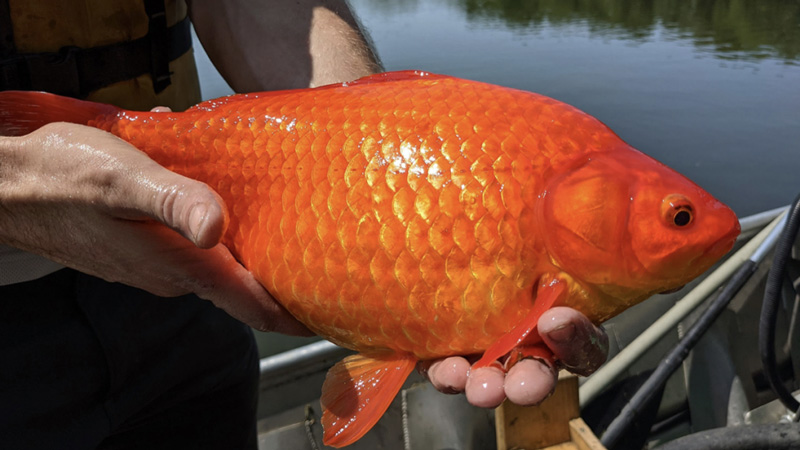
Photo courtesy City of Burnsville
Description
Appearance
Physical characteristics vary greatly. Coloration can include olive green, gold, white, red or orange. The common goldfish lack barbels on the upper jaw, have no scales on their head and their eyes are relatively large. Goldfish (Carassius auratus) are closely related to koi (Cyprinus rubrofuscus) and common carp (Cyprinus carpio), which could be misidentified as goldfish. The typical length of a goldfish is between 5-8 inches, but they can reach close to 2 feet long. They can weigh up to 6 pounds (USGS). Goldfish are often found in groups of a dozen or more, up to several thousand fish.
Body shape and fins
Generally, goldfish have an elongated, stocky, football-shaped body. They have a long dorsal fin (with 15-21 fin rays), and a forked tail fin.
 Photos courtesy Jess Norby, Carver County Water Management Organization.
Photos courtesy Jess Norby, Carver County Water Management Organization.
Biology
Goldfish are a freshwater fish in the carp family. They are omnivorous bottom-feeding foragers and crush food such as insects with their pharyngeal teeth. Goldfish are highly tolerant of turbid waters, temperature fluctuations and low levels of dissolved oxygen. Typical habitat includes streams and pools with submerged vegetation. Goldfish reproduction often coincides with fluctuations in the environment. Lifespan is typically 6-7 years.
Origin and spread
The native range of goldfish includes Eastern Asia and parts of Europe. Their high tolerance for a variety of conditions makes them popular pets. Recently, there have been many reports of wild populations of goldfish in Minnesota waters (see EDDMapS for reports). These populations are likely the result of people illegally releasing pet goldfish into Minnesota waters.
Don’t be fooled by these look-alikes
- Prussian carp, Carassius gibelio (invasive, has not been detected in Minnesota)
- Crucian carp, Carassius carassius (invasive, has not been detected in Minnesota)
- Common carp, Cyprinus carpio (invasive)
- Koi, Cyprinus rubrofuscus (invasive)
- Grass carp, Ctenopharyngodon idella (invasive)
- Bigmouth buffalo (native)
Regulatory classification
Goldfish (Carassius auratus) and koi are regulated invasive species in Minnesota, which means it is legal to possess, sell, buy, and transport, but it is illegal to release them into the environment. You may not use goldfish as fishing bait in Minnesota.
Control methods
Like common carp, goldfish populations are very difficult to control. There are several potential options available to manage goldfish including:
- basin manipulation (e.g., dewatering or drawdown)
- physical removal (e.g, netting, seining, capturing)
- predator stocking (e.g. northern pike or largemouth bass)
- pesticide use (e.g. rotenone)
These options will require a permit from the DNR in most instances. Optimal removal methods vary depending on the type of basin (storm water retention basin, public water, or private pond). With any method, control is not a guarantee; therefore, continuous monitoring may be needed to assess goldfish presence or absence.
Adaptive management might also be needed depending on the system. It is recommended to base management on the goldfish behavior, spawning locations and movement. These indicators may help to determine the correct gear and management option for your project.
This handout contains best management practices for goldfish control and information on permitting. Please reach out to your local AIS Specialist with additional questions.
Threat to Minnesota waters
Goldfish populations may cause recreational, economic and ecological damage. Infestations change how residents and visitors use and enjoy Minnesota waters.
- Goldfish reproduce rapidly and can quickly number in the hundreds or thousands.
- Large populations can outcompete native fishes and, in some instances, disrupt sport fisheries.
- Goldfish can increase turbidity by stirring up the sediments when feeding, resulting in a decline in aquatic vegetation and water quality.
- The resulting changes in vegetation can impact habitat for native fish.
- Goldfish can be a host for disease (e.g., Koi herpesvirus [KHV] and carp edema virus [CEV]) that can contribute to large die-offs, resulting in an unhealthy fish community.
What you should do
Help prevent the spread
People spread goldfish primarily through the illegal release from aquariums and water gardens. Protect yourself and the environment by becoming better informed before you buy. You can do this by:
- Knowing the laws in Minnesota. Keep up to date on invasive species regulations.
- You can possess, sell, buy, and transport regulated invasive species, such as goldfish, but they may not be introduced into a free-living state, such as being released or planted in public waters.

 Photos courtesy Jess Norby, Carver County Water Management Organization.
Photos courtesy Jess Norby, Carver County Water Management Organization.- Learning to recognize goldfish, both in pet and aquarium stores and in Minnesota’s aquatic ecosystems.
- Report new occurrences of goldfish to the DNR immediately by contacting your DNR Invasive Species Specialist or log in and submit a report through EDDMapS.
- Learning how your hobby may impact AIS spread. Aquarium owners and water gardeners play an important role in protecting Minnesota waters from aquatic invasive species.
If you have a goldfish you can no longer care for:
- Never release goldfish into the environment.
- Contact a retailer for possible returns.
- Find a surrender event near you to rehome your pet.
- Give or trade with other hobbyists or a local hobbyist society.
- Contact a veterinarian or pet retailer for guidance on humane disposal of goldfish.
- Refer to Habitattitude for alternatives to release.
Pledge to protect Minnesota waters
Pledge to protect Minnesota waters from aquatic invasive species. These AIS are plants, animals and diseases that do not naturally occur in our waters and may cause harm to the environment, the economy, human health or natural resources. Your pledge demonstrates your commitment and care to prevent the spread of AIS in Minnesota. Take the pledge.
Resources
- University of Michigan Animal Diversity webpage
- USGS Nonindigenous Aquatic Species database
- Carver County story map on goldfish invasion
- Goldfish (Carassius auratus) Fact Sheet (MN DNR)
- Goldfish and Koi Best Management Practices (MN DNR)
- Minnesota Aquatic Invasive Species Research Center AIS Identification Guide


